Exploring 07 unique folk art forms in Vietnam - Handspan Travel Indochina
2With a long history, Vietnam is home to many unique traditional art forms imbued with cultural identity. No matter which region of Vietnam you travel to, you can enjoy some art forms. These art forms are a source of pride for Vietnamese people. They are also a way to help tourists better understand Vietnamese culture. Let’s explore these 07 unique folk art forms in Vietnam below with Handspan Travel Indochina!
Through this blog post, you will find detailed information about these art forms below.
Cheo Singing
Cheo Singing dates back to the Dinh Dynasty in the 10th century. It is one of the unique folk art forms in Vietnam. This art type is popular in the Northern Delta region of Vietnam. Unlike other folk art forms in Vietnam, Cheo is a type of theatrical performance imbued with national character and has a unique combination of singing, dancing, music, and drama elements. Cheo singing can be solo, duet, or chorus. A Cheo play lasts about 2 hours. When performing Cheo, the actors must demonstrate all the skills of singing, dancing, and acting on the background music played by musicians using many musical instruments such as drums, two-stringed fiddles, etc.
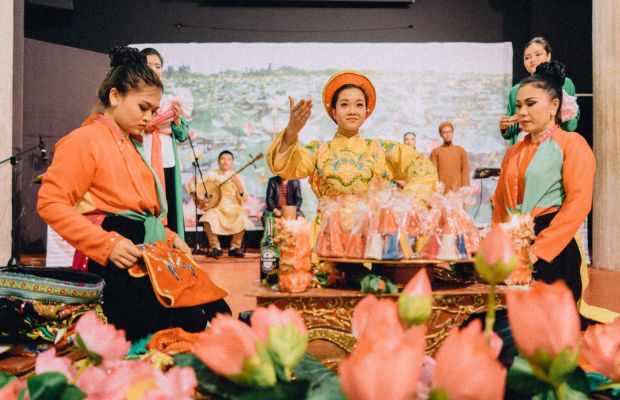
Performing Cheo singing
Through the combination of all the elements above, Cheo's singing shows stories about life, love, and the history of Vietnam. Watching the Cheo performance, you can learn about the simple life of farmers. The singing also praises noble human qualities, criticizes bad habits, opposes injustice, and expresses love, tolerance, and forgiveness. If you travel to Vietnam, don’t miss out on the opportunity to enjoy this art type.
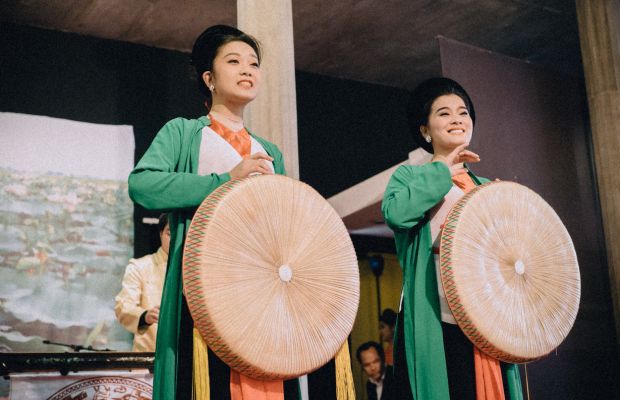
Cheo singing artists
Don Ca Tai Tu (Southern amateur singing)
Don Ca Tai Tu (Southern amateur singing) is also among the folk art forms in Vietnam you should not miss. This featured aspect of the culture in the Mekong Delta region of Vietnam is recognized as an intangible cultural heritage of humanity by UNESCO. This is a traditional art of performance that appeared in the 19th century. It has a variety of performances and musical instruments. Don ca tai tu has its roots in the cultural exchanges between Southern Vietnam and various ethnic groups, including the Khmer, Cham, and Chinese communities.
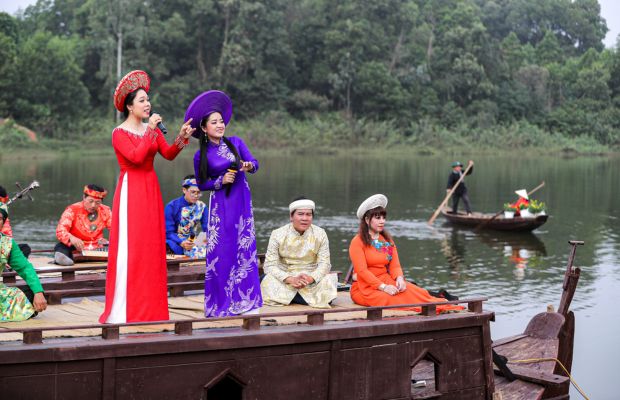
Don Ca Tai Tu
Traveling to the Mekong Delta region of Vietnam, you should not miss listening to this unique type of music. Don ca tai tu combines elements of music, poetry, and performance. It features a small ensemble of musicians playing traditional instruments. They are the đàn tranh (16-string zither), đàn bầu (monochord), đàn nhị (two-string fiddle), đàn cò (bamboo flute), and various percussion instruments. The music is outstanding with its melodic and rhythmic complexity, improvisation, and emotional expression. Each performance of Don Ca Tai Tu includes a wide range of traditional melodies and songs. Many of these are based on folk tunes and poetic lyrics that reflect the themes of love, nostalgia, and rural life.
In general, Don ca tai tu plays a significant role in Southern Vietnamese culture, serving as a form of entertainment, social bonding, and cultural expression. Not only on special occasions like festivals and weddings, you can also enjoy this type of music at communal events and the weekends in the floating markets.
Ca Tru (Vietnamese ceremonial singing)
Ca Tru (Vietnamese ceremonial singing) is also among the meaningful folk art forms in Vietnam. It is associated with festivals, customs, reliefs, literature, ideology, and philosophy of life of Vietnamese people. This art form also has many different names such as hat a dao, hat cua dinh, hat cua quyen, hat co dau, hat nha to, hat nha tro, and hat ca cong, etc. It is a type of art with a strong "chamber" character, with a smooth and high-level coordination between poetry, music, and sometimes even dance and performance. In 2009, Ca Tru was officially declared as an Intangible Cultural Heritage of Humanity by UNESCO.
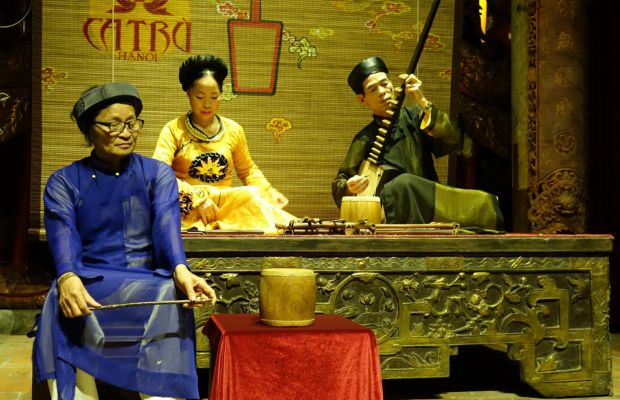
Performing Ca Tru
Like many other folk art forms in Vietnam, Ca Tru art is popular in many regions of Vietnam. It is currently present in 14 provinces and cities of Vietnam. They include Hanoi, Phu Tho, Vinh Phuc, Bac Ninh, Hai Duong, Hung Yen, Hai Phong, Thai Binh, Nam Dinh, Thanh Hoa, Nghe An, Ha Tinh, Quang Binh and Ho Chi Minh City.
Tuong singing (Vietnamese opera singing)
Tuong singing (Vietnamese opera singing) is also one of the unique folk art forms in Vietnam. Artisans perform this art type on stage with a combination of elements such as music, dance, acting, and costumes. It is most famous in the Central region, in the provinces of Nghe An and Ha Tinh. This traditional art form often depicts stories about history, religion, and folk culture. In particular, Tuong's stories often revolve around stories about examples of self-sacrifice for a great cause, loyalty to the country, lessons about human behavior, etc.
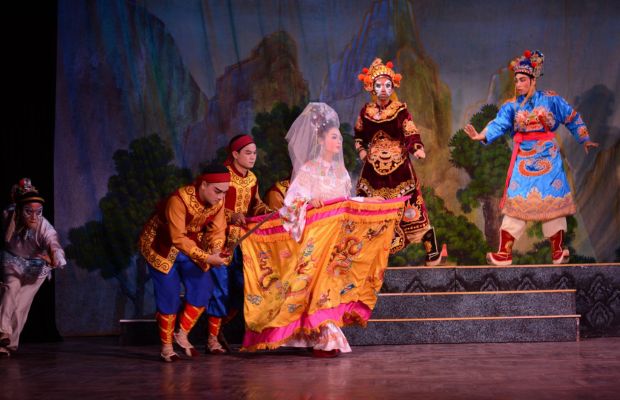
Tuong singing performance
The actors performing Tuong are made up very prominently and are personalized with different colors to distinguish the roles. Red is loyal, gray is a flatterer, green is a ghost and black is an honest person. The makeup and costume style are unique features that make Tuong special.
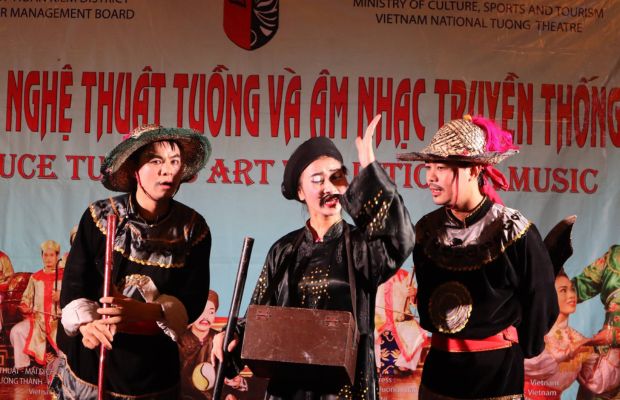
Tuong singing artists
Xoan singing
Xoan singing, which originated from Phu Tho Province in the North of Vietnam, is also one of the outstanding folk art forms in Vietnam. It was recognized as an intangible cultural heritage in 2011. This type of art is often performed during festivals at the beginning of the year when spring comes. It is a performance music with all forms of singing, such as spoken singing, reciting singing, poetry, and songs.
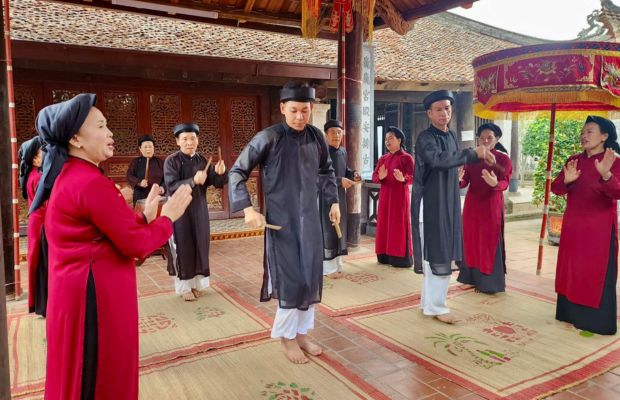
Xoan singing performance
This type of traditional art form stands out with its combination of singing and dancing. Dances follow the singing to illustrate the lyrics. The dance and singing performances usually follow a certain order. The opening is 4 ritual performances, with the content of prayers and blessings. Next is the singing part describing labor and life in the countryside, praising natural scenery, and telling old stories. After the singing part comes the folk performances with strong lyrical content, resembling folk songs, love songs, and drum singing. Each successive performance here is often associated with dance movements and formations, or a performance style of a cartoon nature.
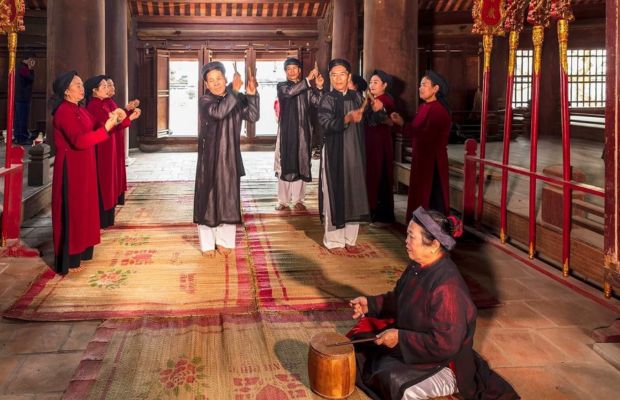
Performing Xoan singing
Quan Ho Bac Ninh (Bac Ninh folk songs)
Quan Ho Bac Ninh is also among the superior folk art forms in Vietnam. It has existed for a long time. This type of art is a form of love singing between men and women. This is one of the typical folk songs of the Red River Delta. While performing Quan Ho Bac Ninh, the men will wear traditional costumes with turbans and Ao The, and the women will be graceful in Ao Mo Ba, Mo Bay, and have conical hats on their heads. They will sing together simple, soulful songs, singing in the traditional way without the need for musical accompaniment but still full of music, expressing the delicate culture of Quan Ho singers.
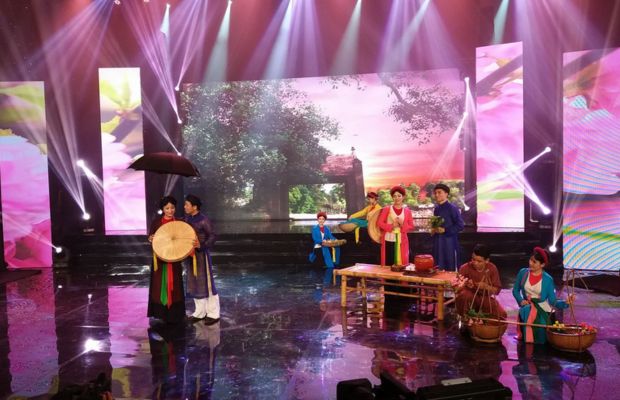
Quan Ho Bac Ninh performance
This art form has many meanings in art, culture, society, and human education. Quan Ho has become an indispensable part of the life and soul of the people in the Quan Ho region, becoming their typical custom. Quan Ho's singing helps connect the community, creating emotional exchanges and strong solidarity. Many Quan Ho songs contain educational words to encourage feelings, and solidarity and preserve the beauty of traditional Vietnamese culture.
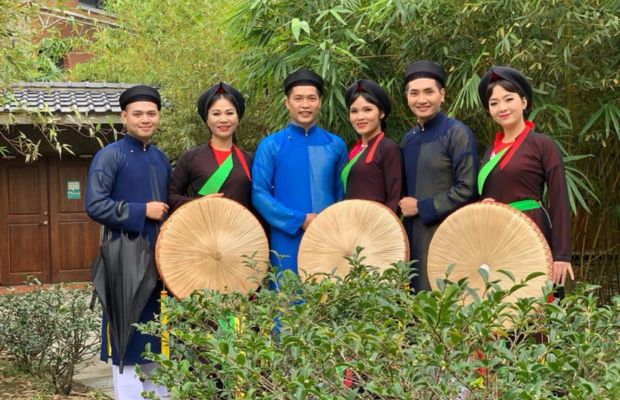
Quan Ho Bac Ninh artists
Water puppets
Water puppetry, which is widely popular in the Red River Delta, has been one of the folk art forms in Vietnam for more than a hundred years. Watching a puppet show will be a suitable choice if you would like to learn about Vietnam's traditional customs and culture. This art form depicts farming activities. They are farming, fishing, pounding rice, raising ducks, etc., and humorous stories in daily life. Under the skillful hands of the artisans, water puppetry reflects the lives of the people in a vivid and authentic way.
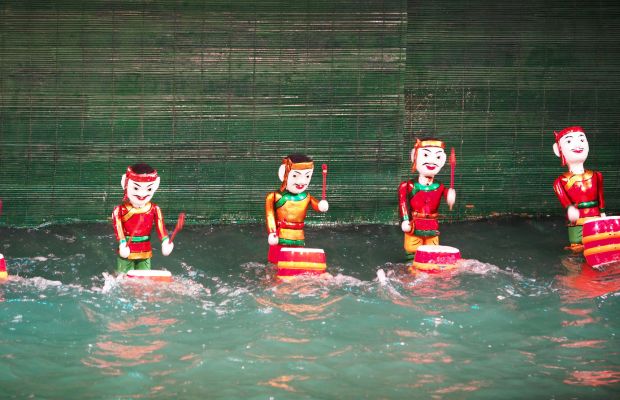
Water puppet shows
This art form originated from the games and visual arts of farmers. When they had a need for entertainment, they carved trees and created puppets, initially with crude shapes and gradually perfected with more sophistication and artistry, transforming them into interesting characters performing on the water. Water puppetry performances with skillful and delicate control by artisans are full of creativity, and attractive, showing the rustic and simple nature of Vietnamese life.
Currently, there are about 23 water puppet theaters operating across Vietnam. These are places that preserve hundreds of unique performances and a great passion for the art form of water puppetry passed down through many generations. Traveling to Vietnam, don’t miss out on the opportunity to learn about this traditional art form and watch an exciting water puppet show.
In conclusion, you have just learned about the 07 folk art forms in Vietnam. These art forms not only help you entertain but also help you understand a part of Vietnamese people’s lives. If you want to have more information, book a Vietnam tour package, or tailor your tour to meet your needs of watching these art forms, please do not hesitate to contact our team.
__logo.png)
__hanoi-water-puppets.jpg)
__angkor-wat-blue-reflections.jpg)
__vientiane-buddha-park-monks.jpg)
__bagan-dhammayazika-dusk.jpg)
